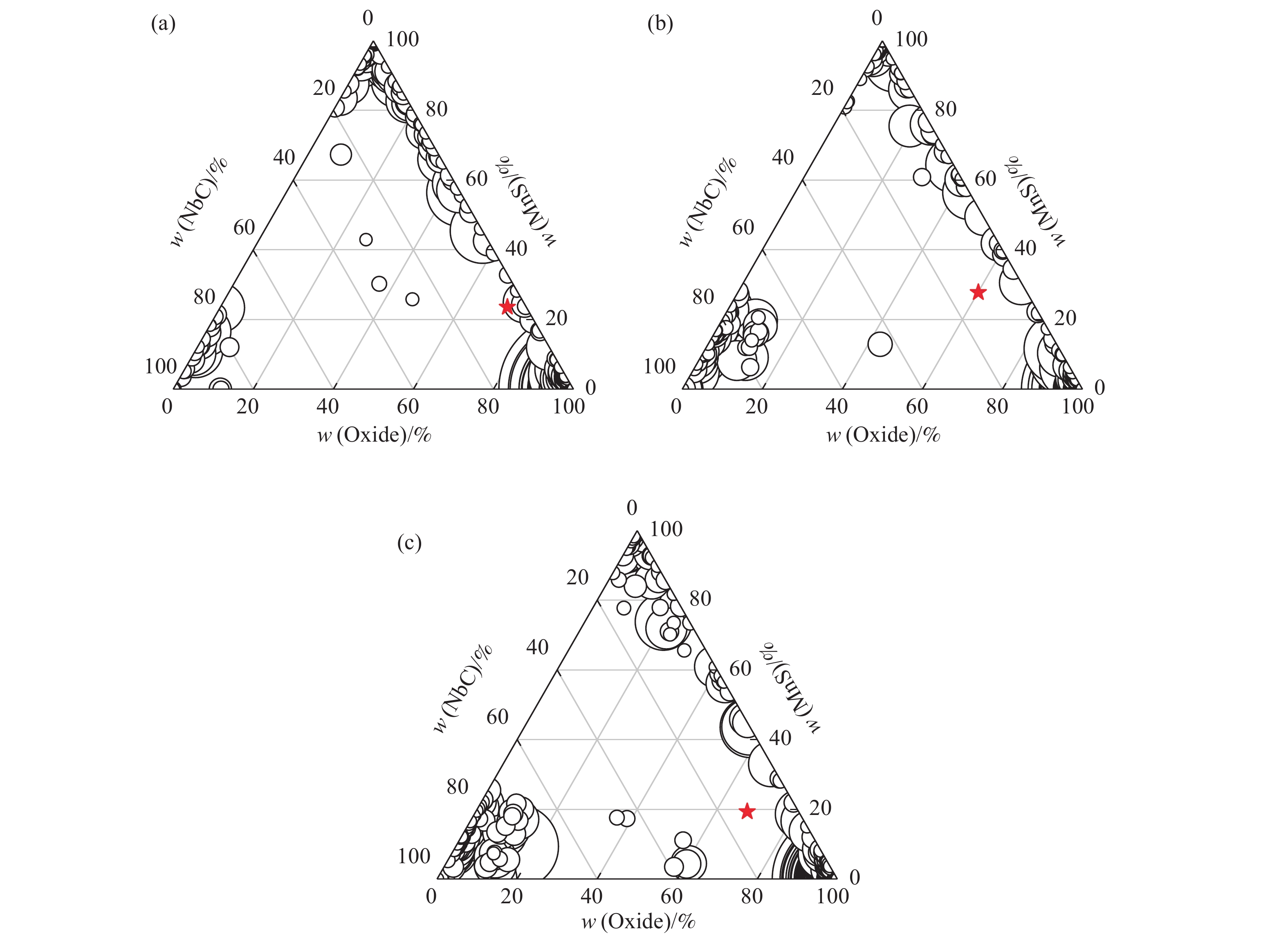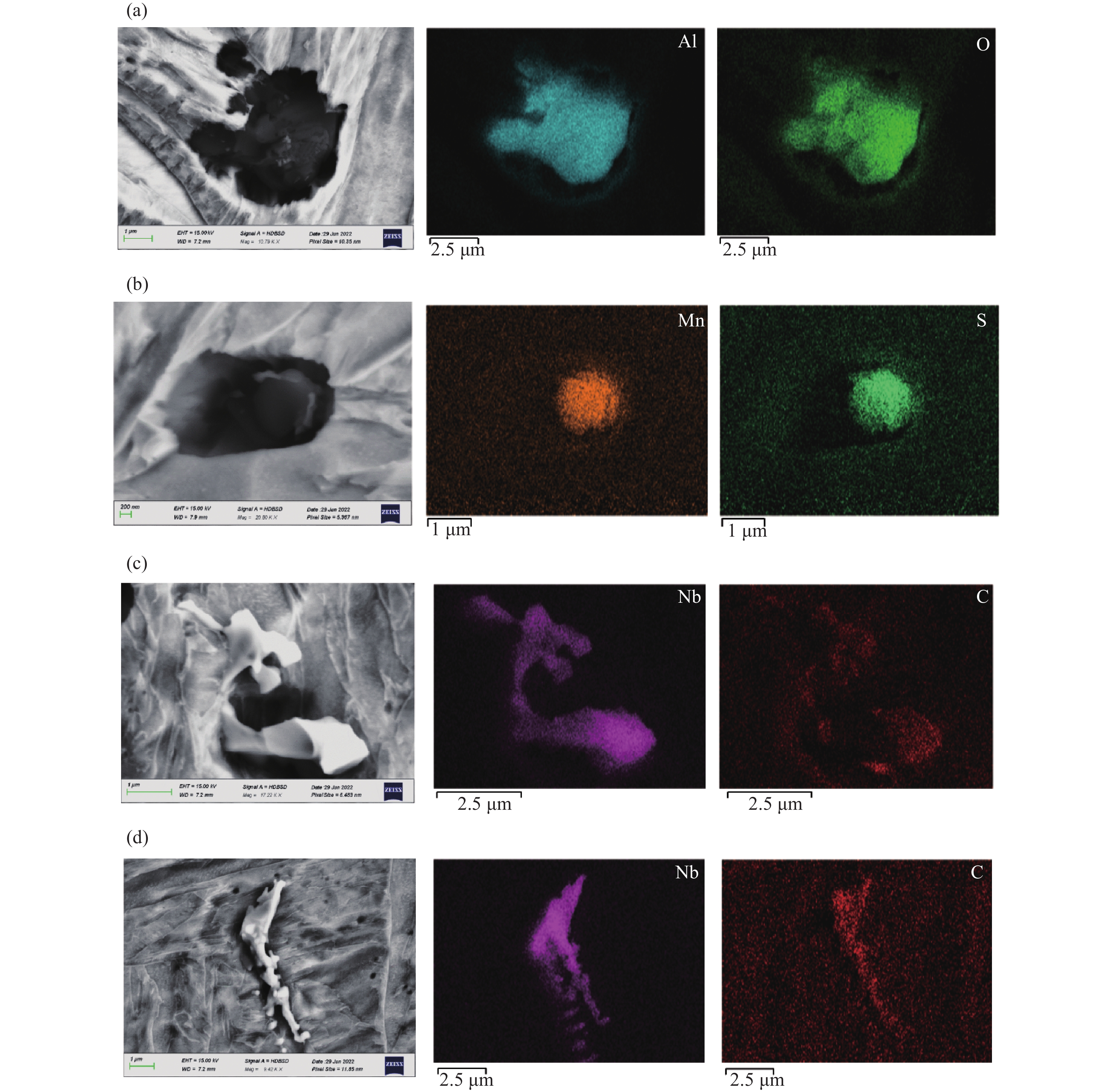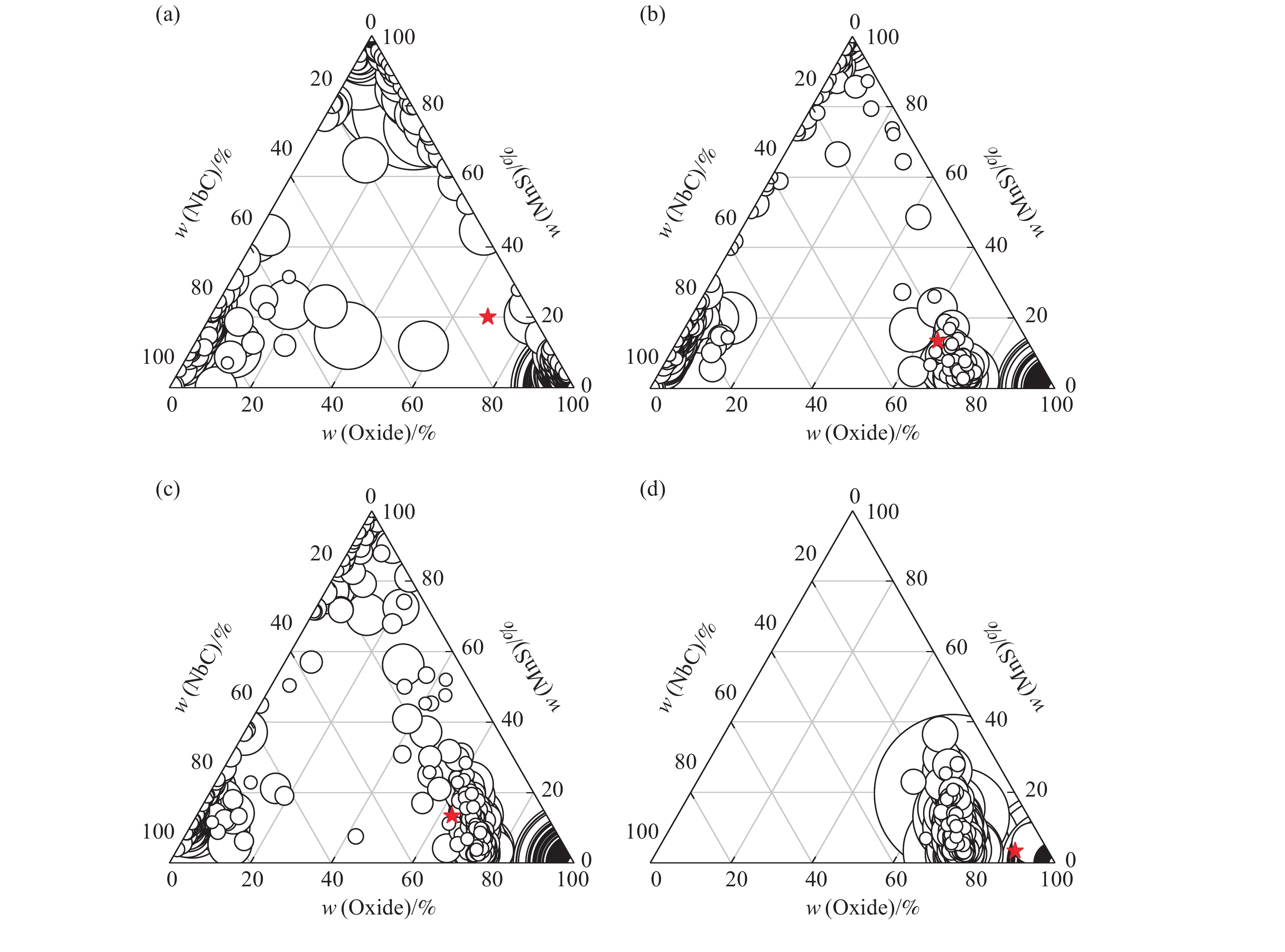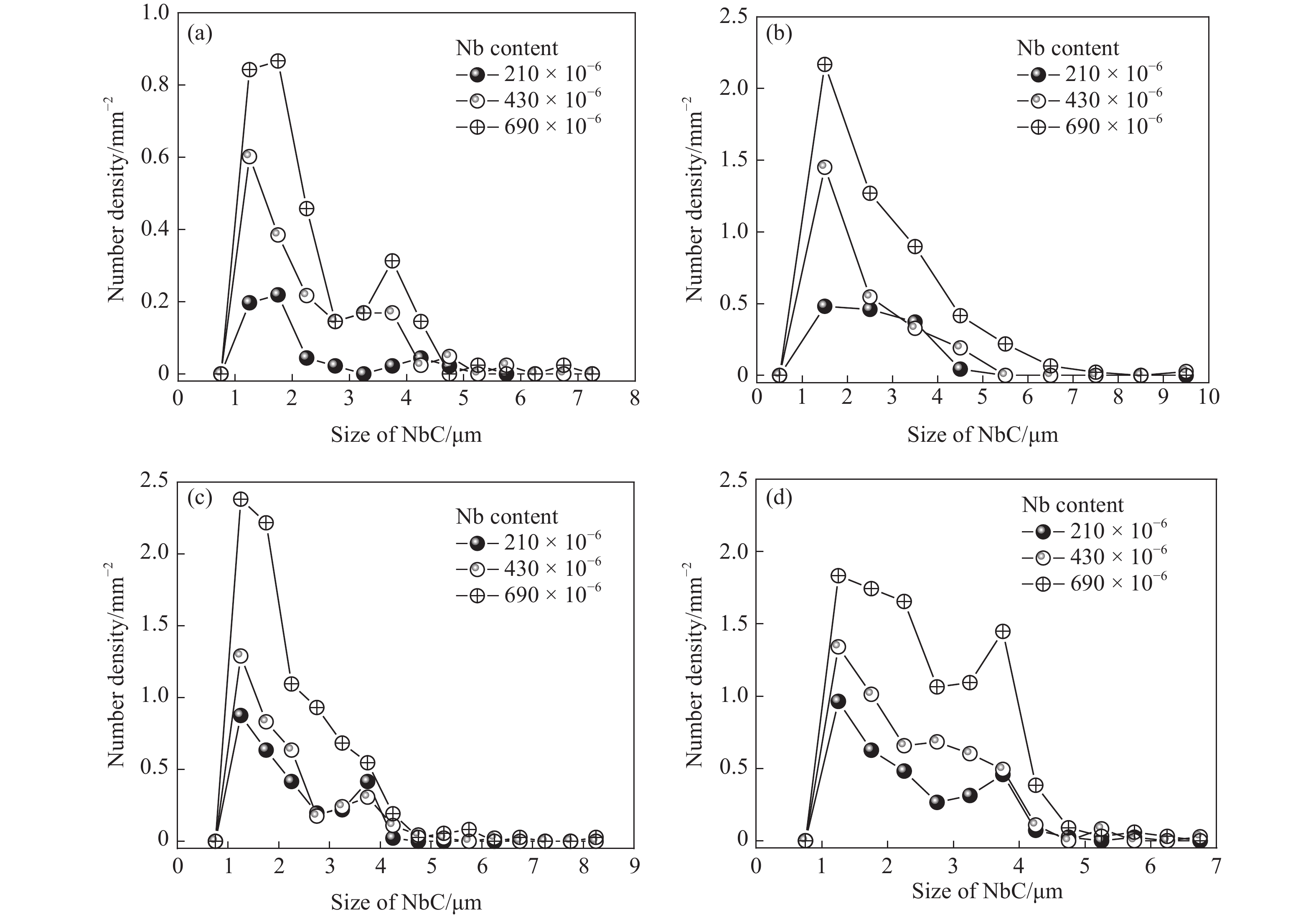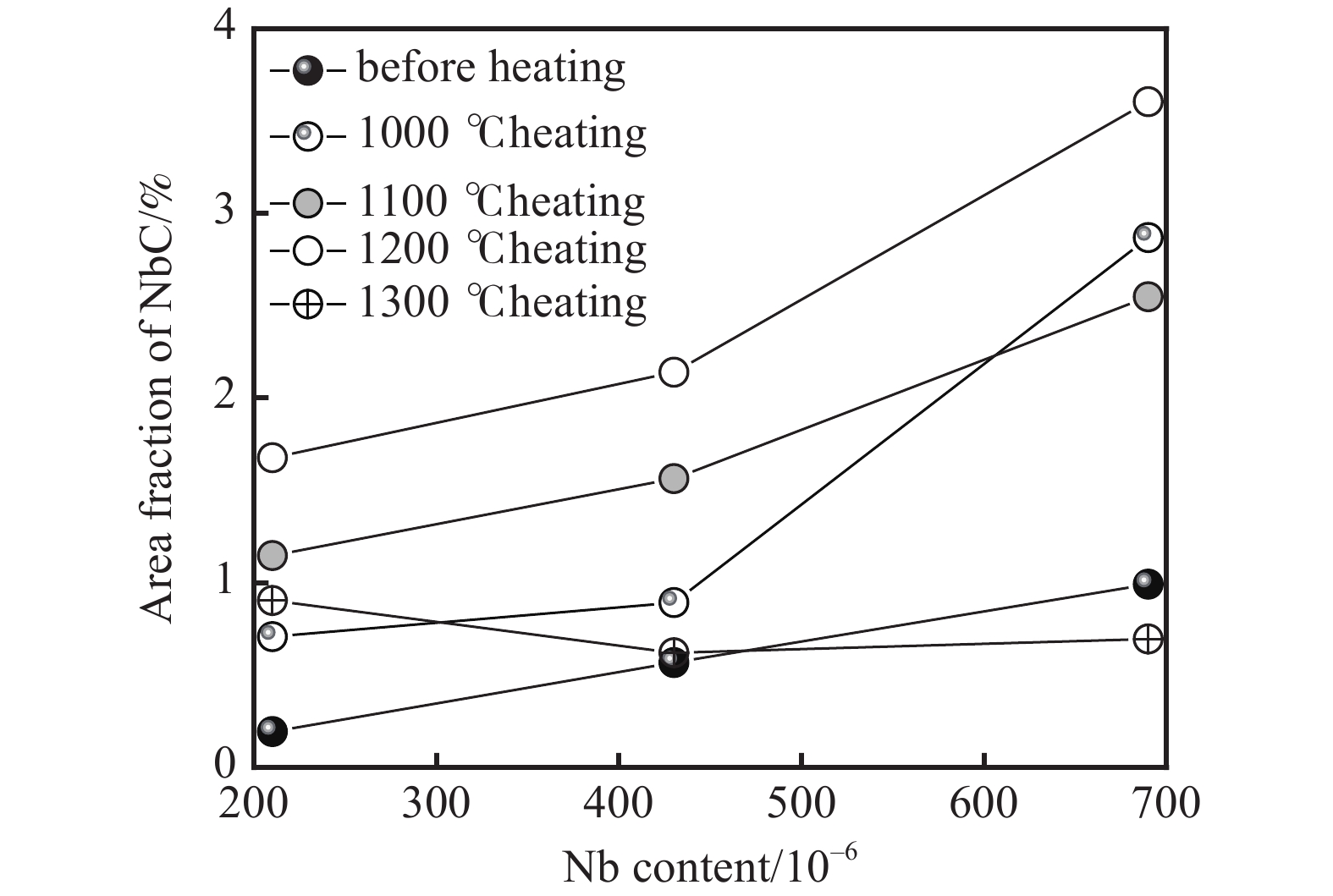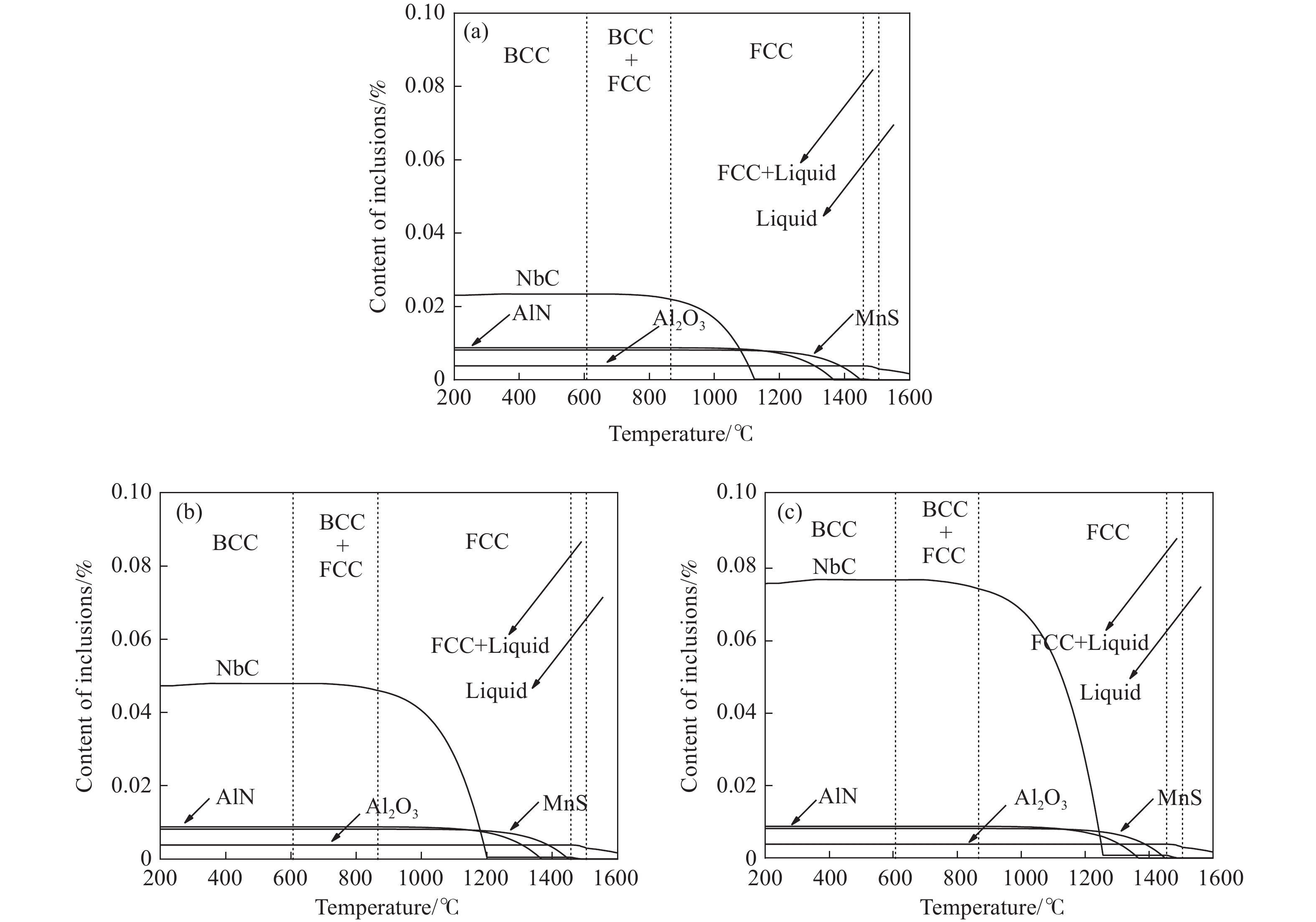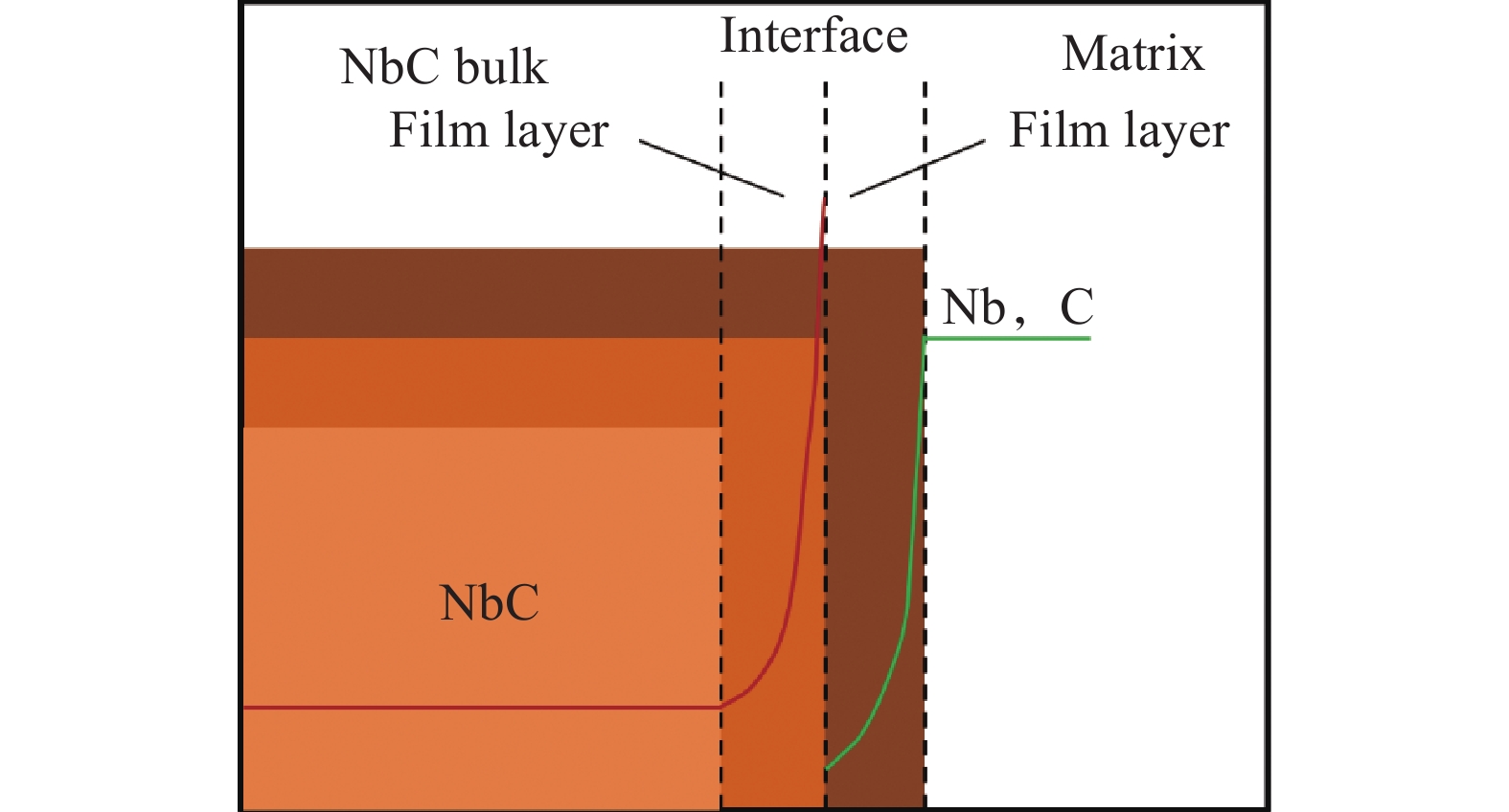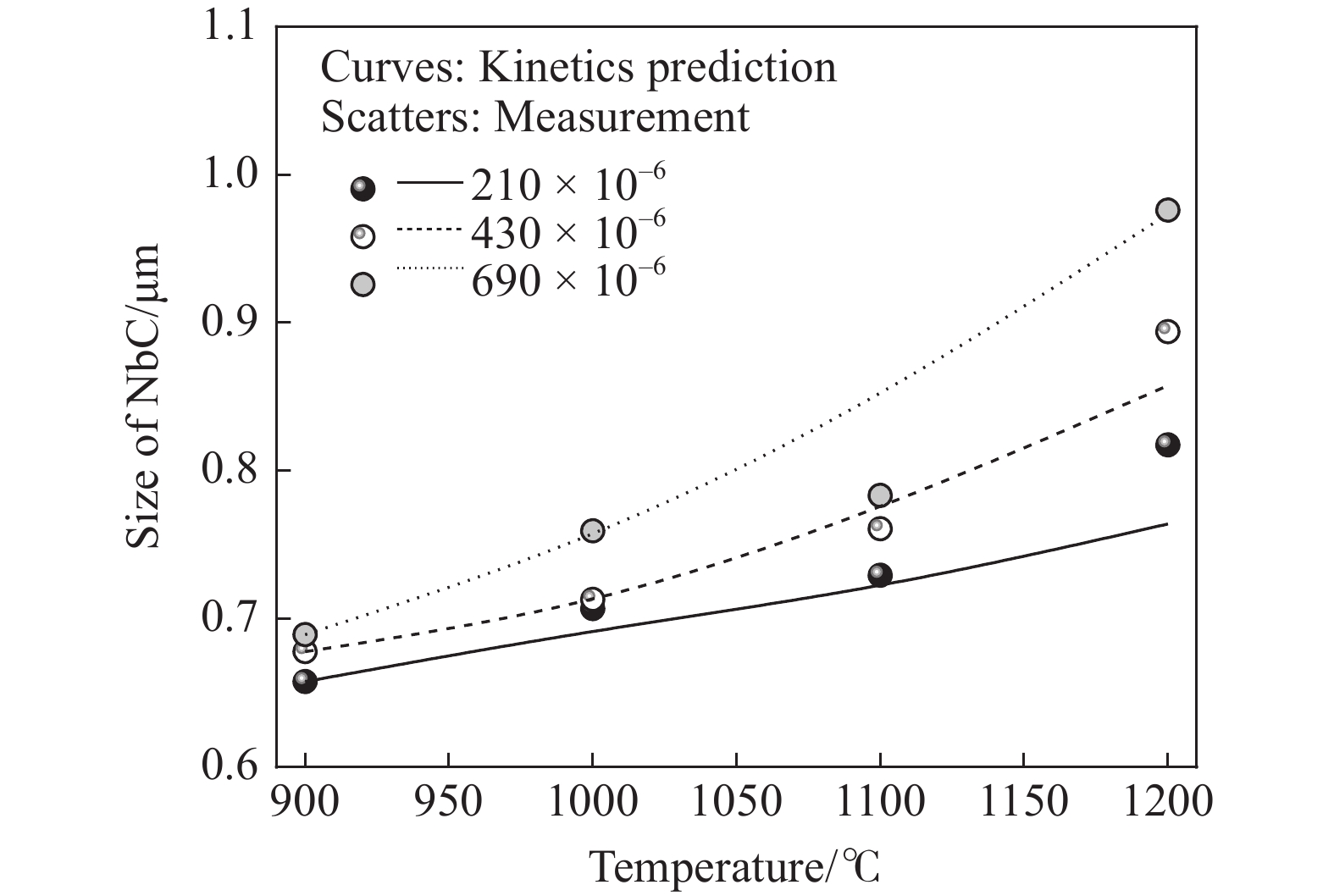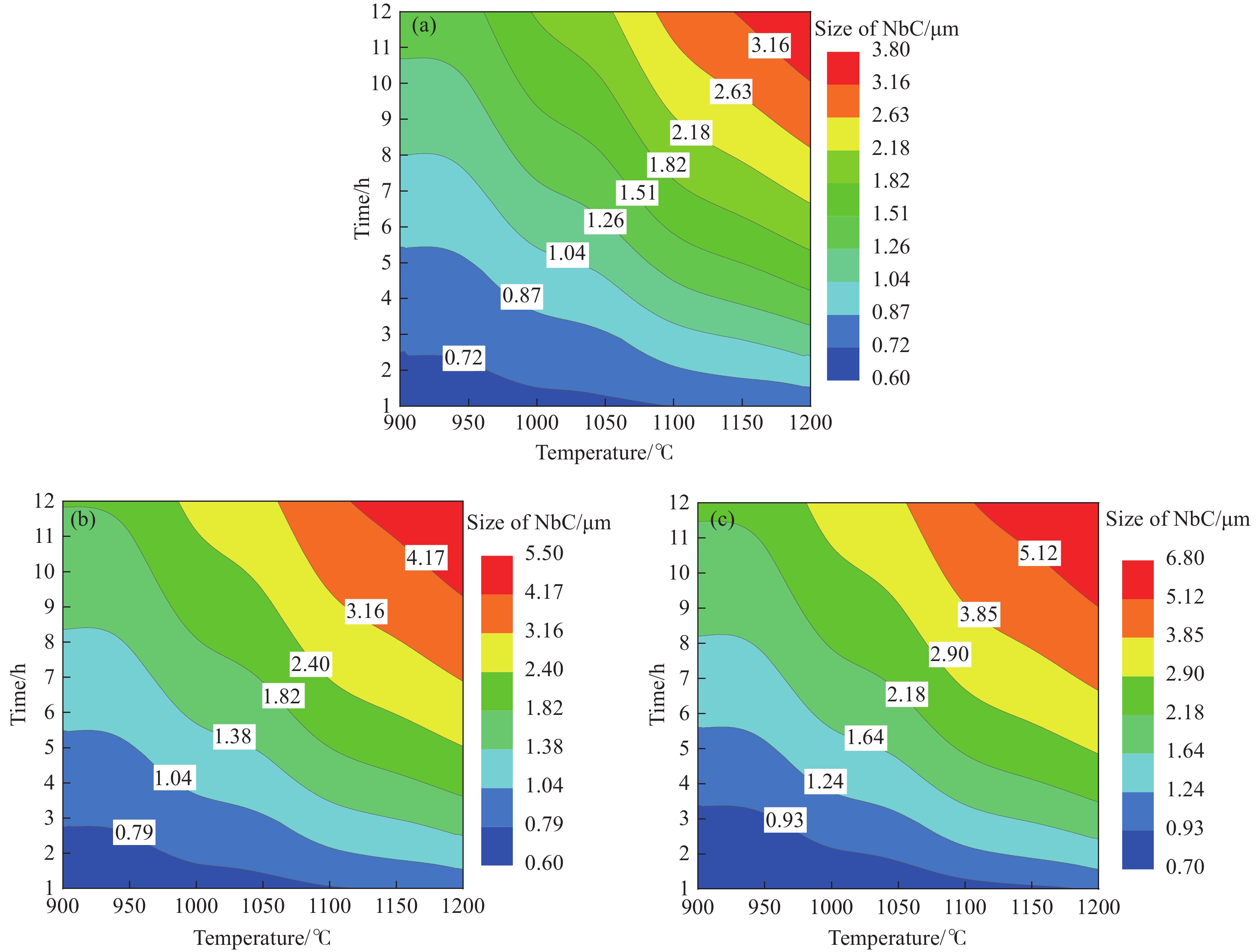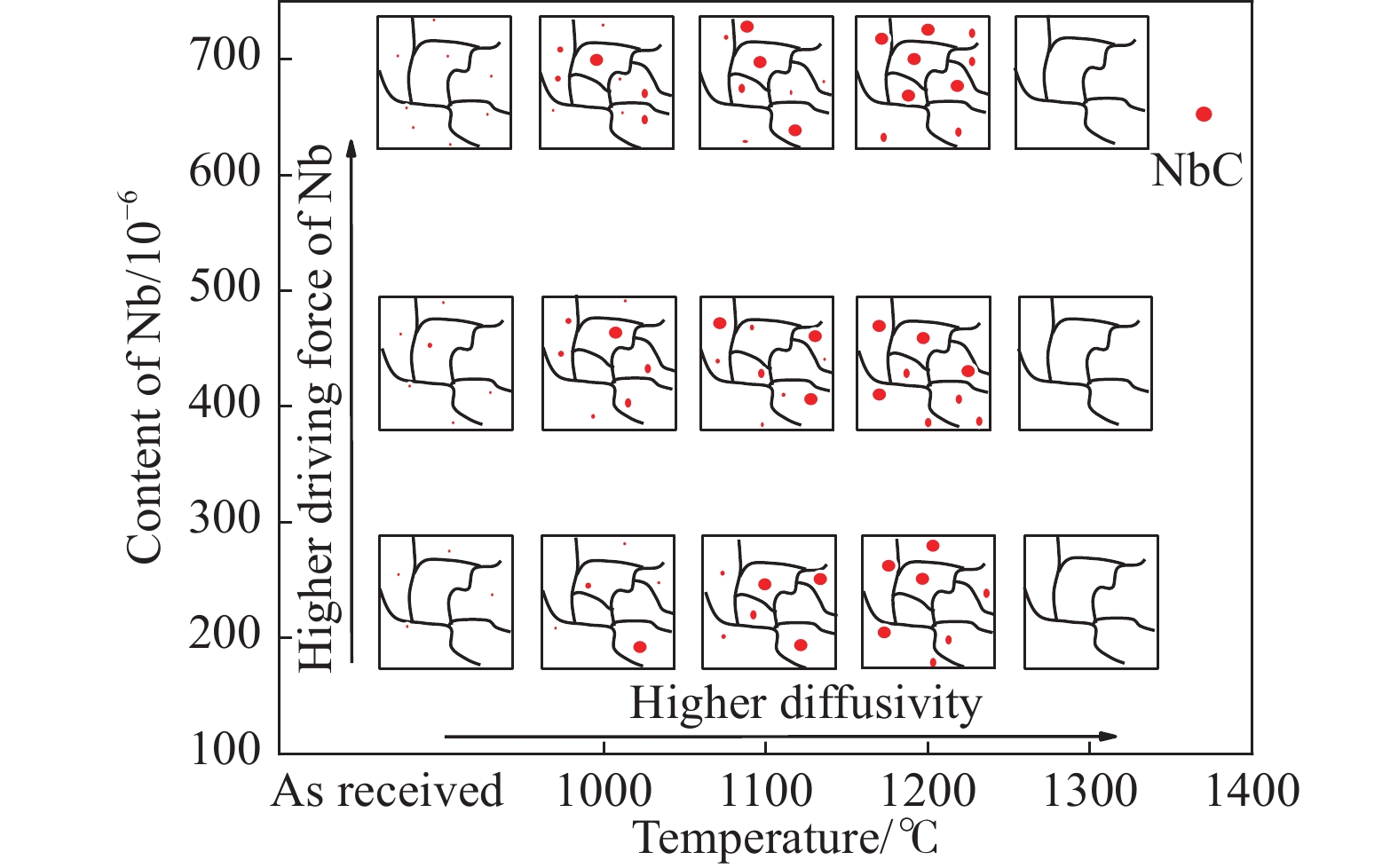-
摘要: 微合金化與熱處理工藝是提升鋼材性能最主要的兩種方法。本文以DH980高強鋼中NbC析出相為對象,研究了鈮含量分別為210 × 10–6、430 × 10–6和690 × 10–6和熱處理溫度分別為1000、1100、1200和1300 ℃的條件下,高強鋼中NbC析出相的析出行為。使用高溫硅鉬爐熔煉DH980連鑄坯并添加不同Nb含量進行鈮合金化,再將所得水冷樣置于硅鉬爐中完成不同溫度下的熱處理實驗,然后使用夾雜物自動掃描電鏡對實驗樣品進行夾雜物掃描、統計。經分析,鈮微合金化后的高強鋼中主要的夾雜物為Al2O3、MnS和NbC,其中,NbC析出相的尺寸范圍為0.7~6.0 μm,而1.0~2.0 μm尺寸的NbC居多。使用Factsage熱力學計算軟件計算NbC析出溫度及析出量,隨著鋼中鈮含量從210 × 10–6增加至690 × 10–6,NbC析出相的最高析出溫度逐漸升高,分別為1125、1200和1260 ℃,NbC析出率(NbC質量與所有夾雜物質量的比值)也逐漸從0.023%增加至0.047%、0.076%。MnS的析出溫度為1450 ℃,不隨Nb含量的變化而變化。鋼中NbC析出量隨著鈮含量的增加而增加,也隨著熱處理溫度的升高而增加。當熱處理溫度為1300 ℃時,NbC出現回溶現象,導致析出量減少。NbC尺寸主要與初始Nb含量、熱處理溫度、保溫時間有關,NbC尺寸會隨著Nb含量、熱處理溫度、保溫時間的提高而增加。本研究中建立了高強鋼中NbC析出動力學模型,預測了鋼中鈮含量、熱處理溫度、熱處理時間對NbC析出相尺寸的影響。Abstract: Microalloying and heat treatment are the most important ways to improve the steel properties . In this study, the precipitation behavior of NbC precipitates with Nb content of 210 × 10–6, 430 × 10–6, and 690 × 10–6 and heat treatment temperature of 1000, 1100, 1200, and 1300 ℃ were investigated. DH980 slab was melted in a silicon–molybdenum heating furnace with different Nb additions. The water-quenched steel samples were heated at different temperature in a furnace. The morphology and chemical composition of inclusions in steel samples were determined using an inclusion analysis system. The main inclusions in the Nb micro-alloyed high-Al high-strength steel were Al2O3, MnS, and NbC. The measured diameter of NbC precipitates ranged from 0.7 to 6.0 μm, which mainly concentrated on 1.0–2.0 μm. The precipitation temperature and amount of NbC were calculated using the thermodynamic calculation software Factsage. The initial precipitation temperature of NbC precipitates gradually increased to 1125, 1200, and 1260 ℃ as the Nb content increased from 210 × 10–6 to 690 × 10–6, respectively, and the NbC precipitation rate (the ratio of NbC mass to the mass of all inclusions) increased to 0.023%, 0.047%, and 0.076%, respectively. The precipitation temperature of MnS was 1450 ℃, which changed little with the content of Nb. Al2O3 was present at the melting temperature of steel. The amount of the precipitated NbC in steel increased with an increase in Nb content and heat treatment temperature. The NbC was dissolved in steel when the heat treatment temperature was 1300 ℃, resulting in a decrease in the precipitation of NbC. The size of the NbC precipitates was mainly influenced by the Nb content, heat treatment temperature, and heating time. With the increase in the initial Nb content, the difference in Nb content between the steel matrix and reaction boundary became larger, the diffusion driving force increased, and thus the size of NbC precipitates increased. The diffusion coefficient of Nb varied with the heat treatment temperature, which was hardly influenced by the Nb content. The diffusion coefficient increased with the increase in temperature, which promoted the diffusion of Nb. Consequently, the size of NbC increased with the temperature increased. The diffusivity of Nb increased with an increase in heating time, which also increased the size of NbC. Therefore, the size of NbC precipitates increased as the Nb content, heat treatment temperature, and heating time increased. A kinetic model of NbC precipitation in high-Al high-strength steel was developed to predict the effects of Nb content, heat treatment temperature, and heating time on the size of NbC precipitates.
-
Key words:
- high-strength steel /
- Nb micro-alloying /
- heat treatment /
- NbC precipitate /
- kinetics
-
表 1 鋼樣主要成分(質量分數)
Table 1. Main composition of steel samples
% Sample C Mn T.Al T.S T.N Si P Cr Nb 1 0.210 2.200 0.800 0.003 0.003 0.600 0.005 0.400 0.021 2 0.043 3 0.069 表 2 夾雜物成分(質量分數)
Table 2. Composition of inclusion elements
% C O Al Si S Fe Mg Ca Mn P Ti N Nb Mo 3.4 16.2 48.6 0 0 0 4.6 0 0 0 0 0 0 0 表 3 熱處理過程中C和Nb擴散系數和平衡質量分數
Table 3. Diffusion coefficients and equilibrium concentration of C and Nb during heat treatment process
T/oC wNb,eq/% DNb/(10–15 m2·s–1) DC/(10–7 m2·s–1) 900 0.00 0.828 2.05 950 0.00 0.934 2.19 1000 0.00 1.72 2.34 1050 0.00 2.35 3.44 1100 0.00 4.27 4.67 1150 0.00 5.68 7.63 1200 0.00 7.73 14.5 中文字幕在线观看表 4 熱處理過程中析出相動力學計算參數
Table 4. Calculation parameters of the kinetics of precipitates during heat treatment
L0/μm Mm/(kg·mol–1) MNbC/(kg·mol–1) ρm/(kg·m–3) ρNbC/(kg·m–3) 0.67 0.056 0.105 7.64×103 7.70×103 -
參考文獻
[1] Liu Q M, Feng J J. Development and current situation of advanced high-strength steel under the condition of automobile light weight. Steel Roll, 2020, 37(4): 65劉清梅, 封嬌潔. 汽車輕量化條件下先進高強鋼的發展及現狀. 軋鋼, 2020, 37(4):65 [2] Wang H D, Yan J S. Present development and engineering innovation of advanced high strength steel. Metall Equip, 2021(5): 51王海東, 嚴江生. 淺談先進高強鋼發展現狀與工程創新. 冶金設備, 2021(5):51 [3] Du Y F, Li W, Tian Y Q. Application progress of Nb, V and Ti microalloying in TRIP steel for automobile. Heat Treat Met, 2019, 44(8): 50杜一飛, 黎旺, 田亞強. Nb、V、Ti微合金化在汽車用TRIP鋼中的應用進展. 金屬熱處理, 2019, 44(8):50 [4] Zhang C L, Shao Z H, Li J, et al. Application and development of niobium microalloying technology in medium and high carbon steel. Mater Rep, 2021, 35(5): 5102張朝磊, 邵洙浩, 李戩, 等. 鈮微合金化技術在中高碳鋼中的應用現狀與發展. 材料導報, 2021, 35(5):5102 [5] Lu D, Li W F, Ren Y, et al. Transformation of non-metallic inclusions in solid steel during heating process. J Iron Steel Res, 2020, 32(12): 1021魯達, 李維福, 任英, 等. 固態鋼加熱過程中非金屬夾雜物轉變研究進展. 鋼鐵研究學報, 2020, 32(12):1021 [6] Wu K. Mechanical properties analysis of high strength steel for building structure. Dev Guide Build Mater, 2021, 19(1): 119吳坤. 建筑結構用高強度鋼材力學性能分析. 建材發展導向(上), 2021, 19(1):119 [7] Zhang L F. Non-Metallic Inclusions in Steel. Beijing: Metallurgical Industry Press, 2019張立峰. 鋼中非金屬夾雜物. 北京: 冶金工業出版社, 2019 [8] Liu C C, Zhang L F, Ren Y, et al. Review on effect of non-metallic inclusions on pitting corrosion resistance of stainless steel. J Iron Steel Res, 2021, 33(10): 1040劉城城, 張立峰, 任英, 等. 非金屬夾雜物對不銹鋼耐點蝕性能影響的綜述. 鋼鐵研究學報, 2021, 33(10):1040 [9] Li M, Zhang L F, Luo Y, et al. Morphology of inclusions and precipitates in continuous casting slab of an oriented electrical steel. China Metall, 2018, 28(Sup 1): 95李明, 張立峰, 羅艷, 等. 取向硅鋼連鑄坯中夾雜物和析出相的形貌特征. 中國冶金, 2018, 28(增刊1): 95 [10] Shi K W, Jiang D C, Zheng L N, et al. Precipitation control of NbC in medium carbon niobium microalloyed steel. Continuous Cast, 2020, 45(3): 77石可偉, 蔣棟初, 鄭力寧, 等. 中碳鈮微合金化鋼NbC的析出控制. 連鑄, 2020, 45(3):77 [11] Bhattacharyya T, Singh S B, Das S, et al. Development and characterization of C–Mn–Al–Si–Nb TRIP aided steel. Mater Sci Eng A, 2011, 528(6): 2394 doi: 10.1016/j.msea.2010.11.054 [12] Deng X T, Fu T L, Wang Z D, et al. Extending the boundaries of mechanical properties of Ti–Nb low-carbon steel via combination of ultrafast cooling and deformation during austenite-to-ferrite transformation. Met Mater Int, 2017, 23(1): 175 doi: 10.1007/s12540-017-6241-8 [13] Esterl R, Sonnleitner M, Schnitzer R. Influences of thermomechanical treatment and Nb micro-alloying on the hardenability of ultra-high strength steels. Metall Mater Trans A, 2019, 50(7): 3238 doi: 10.1007/s11661-019-05235-8 [14] Funakawa Y, Shiozaki T, Tomita K, et al. Development of high strength hot-rolled sheet steel consisting of ferrite and nanometer-sized carbides. ISIJ Int, 2004, 44(11): 1945 doi: 10.2355/isijinternational.44.1945 [15] Suzuki H G, Nishimura S, Yamaguchi S. Characteristics of hot ductility in steels subjected to the melting and solidification. Trans Iron Steel Inst Jpn, 1982, 22(1): 48 doi: 10.2355/isijinternational1966.22.48 [16] Jha G, Das S, Sinha S, et al. Design and development of precipitate strengthened advanced high strength steel for automotive application. Mater Sci Eng A, 2013, 561: 394 doi: 10.1016/j.msea.2012.10.047 [17] Jung J, Lee S J, Kim S. Effect of Ti additions on micro-alloyed Nb TRIP steel. Steel Res Int, 2011, 82(7): 857 doi: 10.1002/srin.201000273 [18] Shanmugam S, Tanniru M, Misra R D K, et al. Microalloyed V–Nb–Ti and V steels Part 2–Precipitation behaviour during processing of structural beams. Mater Sci Technol, 2005, 21(2): 165 doi: 10.1179/174328405X18656 [19] Sobral M, Mei P, Kestenbach H J. Effect of carbonitride particles formed in austenite on the strength of microalloyed steels. Mater Sci Eng A, 2003, 367(1): 317 [20] DeArdo A J. Metallurgical basis for thermomechanical processing of microalloyed steels. Ironmak Steelmak, 2001, 28(2): 138 doi: 10.1179/030192301678055 [21] Shibata, Tanaka, Kimura, et al. Composition change in oxide inclusions of stainless steel by heat treatment. Ironmak Steelmak, 2010, 37(7): 522 doi: 10.1179/030192310X12700328925903 [22] Jandová D, Kasl J. Effect of heat treatment and microalloying on toughness of cast low carbon steel. Mater Sci Forum, 2005, 531(500-501): 489 [23] Kheirandish S, Noorian A. Effect of niobium on microstructure of cast AISI H13 hot work tool steel. J Iron Steel Res Int, 2008, 15(4): 61 doi: 10.1016/S1006-706X(08)60145-4 [24] Pang Q H, Guo J, Li W J, et al. Complex precipitation mechanism of Ti–Nb–V microalloyed bainitic base high strength steel. J Wuhan Univ Technol, 2019, 34(6): 1444 doi: 10.1007/s11595-019-2211-y [25] Hong S G, Jun H J, Kang K B, et al. Evolution of precipitates in the Nb–Ti–V microalloyed HSLA steels during reheating. Scr Mater, 2003, 48(8): 1201 doi: 10.1016/S1359-6462(02)00567-5 [26] Saito G, Sakaguchi N, Ohno M, et al. Effects of fine precipitates on austenite grain refinement of micro-alloyed steel during cyclic heat treatment. ISIJ Int, 2019, 59(11): 2098 doi: 10.2355/isijinternational.ISIJINT-2019-153 [27] Taniguchi T, Satoh N, Saito Y, et al. Investigation of compositional change of inclusions in martensitic stainless steel during heat treatment by newly developed analysis method. ISIJ Int, 2011, 51(12): 1957 doi: 10.2355/isijinternational.51.1957 [28] Yang Z H, Chen B C. Discussion on the role of microalloyed elements Nb, V and Ti in steel. Gansu Metall, 2000, 22(4): 20楊作宏, 陳伯春. 談微合金元素Nb、V、Ti在鋼中的作用. 甘肅冶金, 2000, 22(4):20 [29] Ren Y, Zhang L F. Effect of Al2O3–SiO2–MnO inclusions on precipitation of MnS in Si–Mn-killed 304 stainless steels. Ironmak Steelmak, 2019, 46(6): 558 doi: 10.1080/03019233.2018.1491170 [30] Kurokawa S, Ruzzante J, Hey A M, et al. Diffusion of Nb in Fe and Fe alloys. Met Sci, 1983, 17: 433 doi: 10.1179/030634583790420628 [31] Tibbetts G G. Diffusivity of carbon in iron and steels at high temperatures. J Appl Phys, 1980, 51(9): 4813 doi: 10.1063/1.328314 [32] Fick A. Ueber diffusion. Ann Der Physik, 1855, 170(1): 59 doi: 10.1002/andp.18551700105 -





 下載:
下載:
